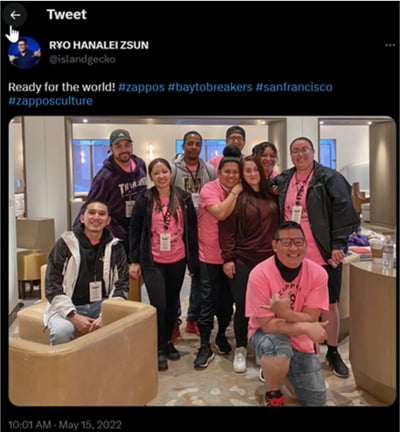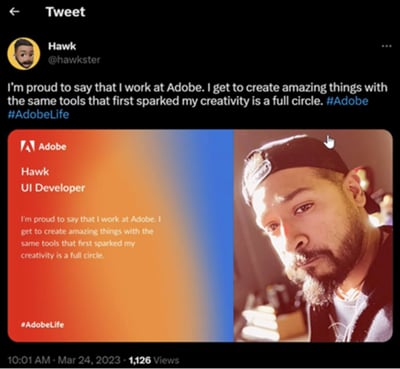
Expert insights
How to launch an employee advocacy program (+ 5 examples)

7 mins read
Start building your digital home with Happeo
Request a demoExpert insights
Platform
Use cases
Solutions
Happeo for
Resources
Explore
Support
Available now
Use Cases
Capabilities
Happeo For
Comparisons
Explore
Support
Recent

Jonathan Davies
7 mins read
Employee advocacy is an increasingly valuable tool for businesses in the digital landscape. By enlisting employees as brand ambassadors, companies can create a robust network of advocates to promote their business, increase brand awareness, and attract new customers.
But how do you launch an effective employee advocacy program?
This article will define employee advocacy, the objectives that should drive your program, and some key benefits. We’ll also share five successful employee advocacy programs with examples of how they look on social media.
Employee advocacy encourages employees to share branded content on their personal social media accounts. Advocacy is for all employees — from top management to entry-level staff.
The first step in launching an effective employee advocacy program is to establish your objectives, such as:
Nearly 50% of chief marketing officers (CMOs) said employee advocacy was the most successful social media campaign they implemented, according to Oktopost’s State of B2B Social Media Marketing Report.
It’s not surprising, considering the many benefits employee advocacy programs offer businesses. Here are some of the most notable ones:
Employee advocacy programs foster greater loyalty among employees by giving them a voice.
With many companies competing for the same customers, you need to stand out.
Implementing an employee advocacy program gives potential customers an inside look at your business and why they should choose you. Employees can share content and experiences that show the value of your products or services.
Employee advocacy programs offer existing customers a more personal experience, as they can connect to the brand through real people who work there.
Promoting loyalty with existing customers leads to higher customer retention and repeat business.
When employees share stories, photos, and videos from their daily work life on social media, they provide an insider’s view that appeals to job seekers.
Implementing an employee advocacy program is a challenging yet rewarding experience, requiring your organization to combine traditional marketing techniques with modern digital solutions. Here are five real-world employee advocacy examples.

The Zappos Twitter account @ZapposCulture provides a behind-the-scenes look at the company and its employees, which helps personalize the brand and promote a positive work culture.
Employees use the hashtags #ZapposCultue and #Zapponians to increase visibility.

Adobe encourages employees to create and share their stories with the world, using the #AdobeLife hashtag, but it also aims to create brand consistency. Adobe’s Social Shift program offers training on the company’s social media policies and shares best practices for sharing content.

Google’s #LifeAtGoogle campaign highlights its employees and the roles they play in the company. The company’s ability to showcase its culture of innovation and creativity helps it attract top talent.

Starbucks provides guidelines for employees on using social media and encourages them to share content as part of its “Starbucks Partners” campaign.
Employees use the hashtags #StarbucksPartners and #ToBeAPartner to drive visibility for the campaign, which has dedicated Facebook and Instagram pages that feature stories, pictures, and videos of employees sharing their experiences.

Cisco’s “We Are Cisco” campaign encourages employees to share stories in their own words, which helps the company build trust with customers and potential employees.
The company uses its We Are Cisco Facebook, Instagram, and Twitter pages to share their employees’ posts featuring the hashtags #WeAreCisco and #LoveWhereYouWork. Driving meaningful conversations about the workplace helps humanize Cisco and promotes a positive work culture.
Here are some tips for launching a successful program:
A supportive company culture enhances employee satisfaction, and happy employees are likely to become brand ambassadors. Provide employees with the right tools, support, and motivation before encouraging them to participate in an employee advocacy program.
Establish clear goals for your employee advocacy program.
Do you want to:
Whatever the goals, make sure they’re clear and measurable, and explain them to employees. For instance, you can set specific goals for each quarter, such as engaging 500 employees in the program or reaching a certain number of followers.
Ensure employees understand your company’s social media policies before participating in the program.
Set guidelines on how to engage with customers, potential employees, and other stakeholders. For example, remind employees to not disclose confidential information.
Other guidelines may include:
Include guidelines in a digital policy document employees can refer to if they need a refresher.
Offer employee social media advocacy training and support to ensure employees understand the program and how it works.
Training should cover:
Encourage open communication between employees and management to ensure everyone knows how the program works and its goals.
Create a platform where employees can ask questions, share concerns, and participate in discussions about the program’s success. This will help build a sense of collaboration, community, engagement, and trust.
Provide employees with engaging content to share on social media to help them promote your company’s message and make it easily accessible.
Examples of shareable content include:
Launch a pilot program. If it’s successful, you can expand the program gradually.
Here are some tips on how to run a successful pilot:
Rewards, such as recognition from leadership or monetary bonuses, motivate employees to participate more actively in the program and make them feel valued for their contributions.
Friendly competitions between departments can help boost participation. For example, you could hold a contest for the most creative post or the post with highest engagement.
Once your employee advocacy program is up and running, keep employees engaged by providing new content regularly.
Encourage them to share ideas. Create polls or surveys to determine the type of content they want to share.
Keep the content fresh and exciting.
Track the performance of your program regularly to ensure it’s meeting your goals.
Some social media metrics you can measure include:
By tracking performance, you can see which content resonates with your audience and how employees engage in the program. Providing employees with data about how their efforts positively affected key metrics like brand awareness or customer retention rates shows the program’s value and encourages future involvement.
There’s no denying the importance of leveraging employee influence to drive business growth.
With the right incentives and encouragement, you can turn staff members into powerful advocates who can spread the word about your company’s products or services. Happeo’s intranet platform can support your employee advocacy program by providing integrated tools to help you engage existing employees and empower them to speak up.
Request a demo to learn more about how Happeo can help support your employee advocacy program.
